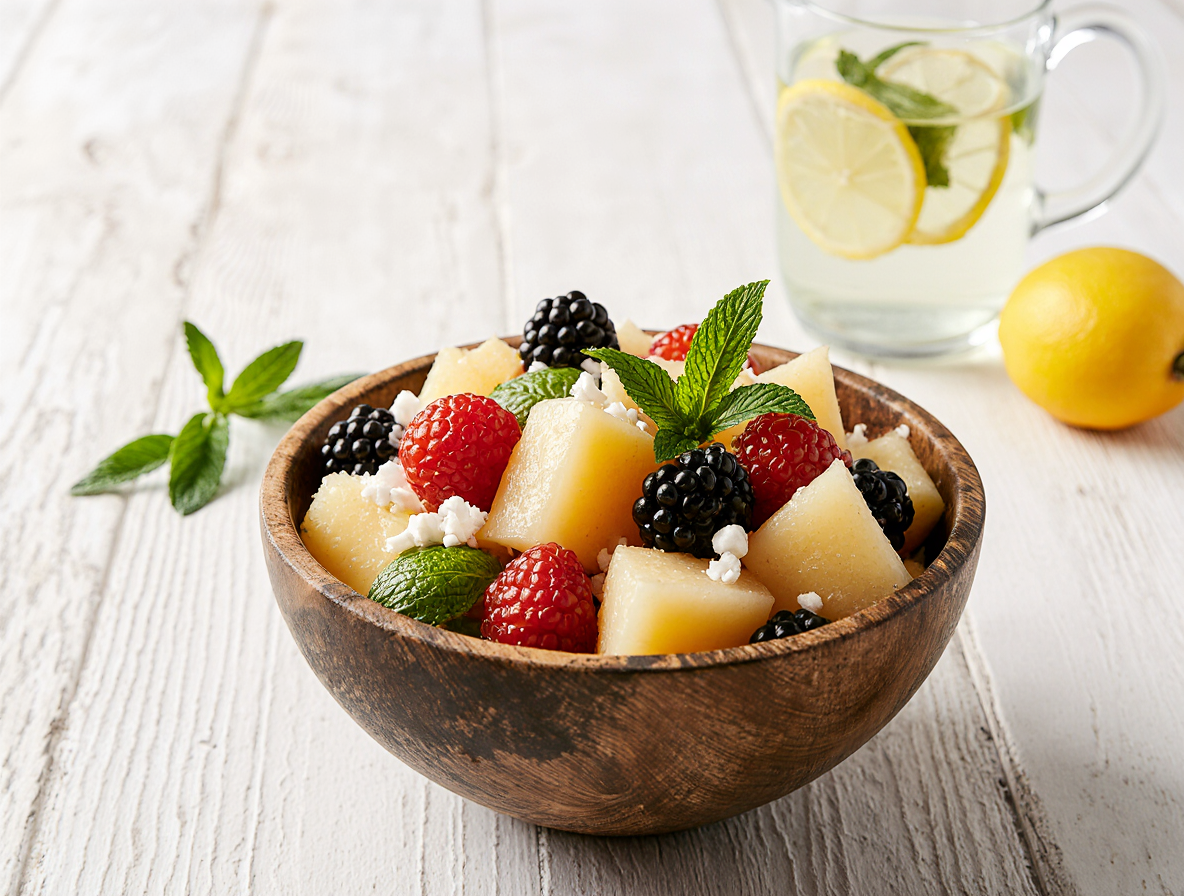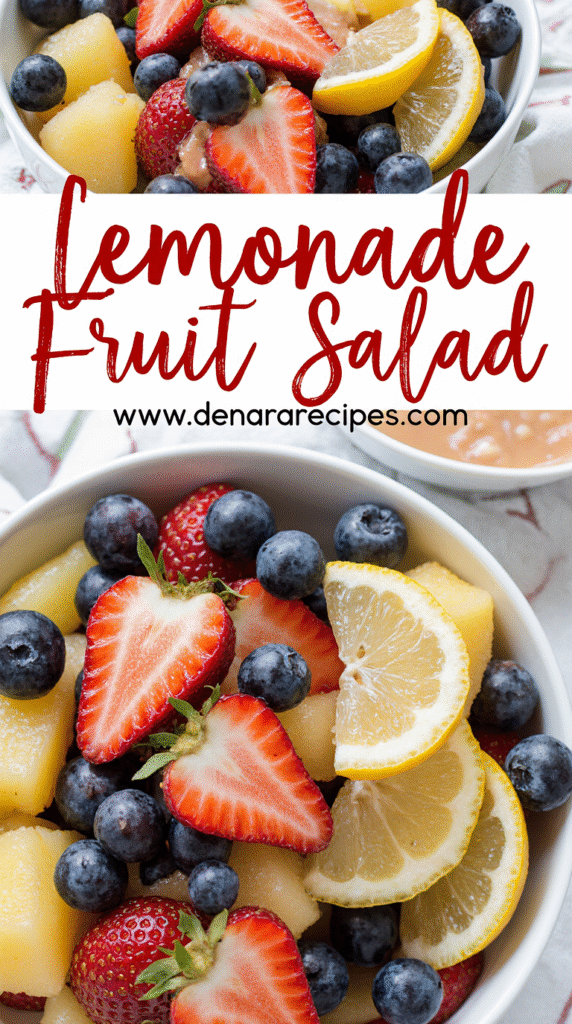How to Make the Perfect Lemonade Fruit Salad: A No-Fail Summer Guide
Summer gatherings demand refreshing treats, and lemonade fruit salad delivers exactly that with minimal effort. This delightful combination of seasonal fresh fruits mixed with frozen lemonade creates a perfect crowd-pleaser that both kids and adults will love.
When you’re looking for ways to incorporate fruit with lemonade, this recipe stands out because the flavors blend beautifully the longer they sit together. Additionally, it’s incredibly versatile – you can make a small batch serving just 6 people or scale it up to feed a crowd of 25 guests. Many people also call this refreshing mixture a “Punchbowl Salad”, which perfectly describes how it can spark up any event.
In this guide, we’ll walk you through selecting the best fruits, preparing the perfect lemonade dressing, and serving this refreshing treat at your next gathering. We’ll also share our tips for making this summer favorite ahead of time by storing prepared fruits in separate bags, ensuring you spend less time in the kitchen and more time enjoying your company.
Choosing the Right Fruits for Your Salad
The perfect lemonade fruit salad starts with choosing fresh, colorful fruits that complement each other in flavor and texture. Creating a visually appealing rainbow of fruits not only makes your salad more attractive but ensures a variety of nutrients and flavors.
Strawberries form the foundation of most lemonade fruit salads, providing vibrant color and natural sweetness. For the best quality, look for berries with vibrant red color, no dark spots, and fresh-looking green tops. Blueberries add beautiful contrast—opt for plump, juicy ones for maximum sweetness. Red or green seedless grapes contribute firmness and juiciness; select those that feel firm and remain tightly attached to their stems.
Other excellent additions include:
- Pineapple (smell the bottom for sweetness; skin should be turning yellow)
- Kiwi (choose slightly soft fruits; firm ones are sour)
- Mandarin oranges (fresh or canned work well)
- Cantaloupe (should have some give when pressed)
However, certain fruits require special consideration. Bananas brown quickly and can make your salad mushy—if using them, add just before serving or coat with lemon juice. Similarly, apples brown rapidly unless treated with citrus juice. Furthermore, melons like watermelon release excess moisture, potentially making your salad watery.
The lemon in your lemonade dressing serves a dual purpose—it enhances flavor while preventing fruits like apples and bananas from browning. Nevertheless, some fruits don’t pair well together. For instance, bananas contain more starch than most fruits and require alkaline for digestion, whereas high-protein fruits need acids.
Importantly, ensure all fruits are thoroughly washed and dried before adding to your salad. Excess moisture can make fruits soften faster. Cut all pieces into similar sizes for a balanced eating experience. Consequently, your lemonade fruit salad will maintain its fresh appearance longer while providing consistent flavor in every bite.
How to Make Lemonade Fruit Salad Step-by-Step
Creating a lemonade fruit salad requires minimal effort yet delivers maximum flavor. The magic happens when tangy lemonade concentrate meets juicy fruit, creating a refreshing summer treat that practically makes itself.
First, thoroughly wash your hands with soap and warm water for at least 20 seconds. This simple step prevents transferring bacteria from your hands to the fresh produce. Next, carefully wash all fruit under cool running water, gently rubbing each piece. For firmer fruits like melons, use a clean vegetable brush to scrub the surface thoroughly.
Once clean, prepare each fruit appropriately:
- Hull and slice strawberries into bite-sized pieces
- Wash grapes and blueberries and remove any stems
- Peel and dice melons into ½-inch squares if using cantaloupe or honeydew
- Slice bananas just before mixing to prevent browning
After preparing all fruits, place them together in a large bowl—a punch bowl works exceptionally well for larger gatherings. The true secret of lemonade fruit salad lies in the next step: adding frozen lemonade concentrate directly to the fruit. This ingenious addition simultaneously chills the fruit while adding sweetness and a tangy lemon flavor.
Gently fold everything together, being careful not to crush softer fruits. The frozen lemonade will gradually thaw among the fruit, creating a delicious natural syrup that coats every piece.
For a delightful variation, some recipes incorporate vanilla pudding mix with the lemonade concentrate, giving the dressing additional body and flavor.
Cover your masterpiece and refrigerate for at least 20-30 minutes prior to serving. This resting period allows the flavors to blend beautifully. Although many fruits maintain their texture for several days, I recommend making and serving the salad on the same day for optimal freshness—especially for special occasions.
The beauty of this recipe lies in its versatility. Adjust fruit quantities based on preference or simply use what’s available in your kitchen.
Tips for Serving, Storing, and Freezing
Properly serving and storing your lemonade fruit salad ensures maximum freshness and flavor for days after preparation. Indeed, with the right techniques, this refreshing treat can remain vibrant and delicious throughout the week.
For serving, plan approximately one cup of lemonade fruit salad per person. This portion size ensures everyone gets enough without risking gastrointestinal issues. At large gatherings or potlucks, consider serving your creation in a metal pan placed over ice, particularly during hot summer days. This method keeps the salad chilled and maintains its texture and flavor.
To preserve freshness, store your lemonade fruit salad in an airtight container in the refrigerator immediately after preparation. The citrus in the lemonade prevents browning and helps maintain vibrant colors. Typically, the salad will stay fresh for 3-5 days when properly stored, though it tastes best within the first three days.
If you’re preparing for a special event, you have several make-ahead options. For next-day serving, simply assemble the complete salad with dressing and refrigerate overnight, giving it a gentle toss before serving to redistribute settled dressing. For preparation up to four days in advance, store chopped fruits separately in their own containers or plastic bags, keeping the dressing in a mason jar until the night before your event.
Regarding bananas, they deserve special attention since they quickly become mushy in storage. I recommend adding banana slices only to portions being served immediately. Moreover, apples and pears benefit from a quick dip in acidulated water (1 cup water with 1 teaspoon lemon juice) to prevent browning.
Surprisingly, lemonade fruit salad freezes beautifully! Place it in airtight containers or freezer bags with air removed for up to three months. Upon thawing, it develops a delightful slushy texture after sitting at room temperature for about 20-30 minutes. Alternatively, blend the frozen fruit salad into smoothies for a refreshing breakfast option.
Remember that any fruit salad left at room temperature for more than two hours should be discarded. Generally, minimizing handling and keeping the salad chilled as much as possible extends its shelf life.
Conclusion
Lemonade fruit salad stands out as the perfect summer refreshment, combining seasonal fruits with frozen lemonade concentrate for a delightful treat anyone can create. Throughout this guide, we’ve explored everything you need to make this crowd-pleaser shine at your next gathering.
Undoubtedly, the success of your salad depends largely on selecting fresh, colorful fruits that complement each other while paying attention to those that require special handling. The magic truly happens when tangy lemonade concentrate meets these juicy fruits, creating that refreshing flavor profile everyone loves.
Proper storage extends the life of your creation significantly. Your fruit salad can last 3-5 days when stored correctly, though it tastes best within the first three. Additionally, freezing offers a surprising option for extending enjoyment even further, transforming your leftovers into delicious smoothies.
We hope this guide has given you the confidence to create this simple yet impressive dish. The beauty of lemonade fruit salad lies in its adaptability—adjust the fruits based on what’s available or your personal preferences. Most importantly, remember that this dish allows you to spend less time in the kitchen and more time enjoying summer moments with friends and family. Your next backyard barbecue or poolside gathering deserves this refreshing, no-fail treat that celebrates summer’s bounty.
FAQs
Q1. What fruits work best in a lemonade fruit salad? Strawberries, blueberries, seedless grapes, pineapple, kiwi, and mandarin oranges are excellent choices. These fruits complement each other in flavor and texture while maintaining their freshness when mixed with lemonade.
Q2. How do you keep fruit salad from turning brown? The lemon in the lemonade concentrate helps prevent browning. For fruits like apples or bananas that brown quickly, add them just before serving or coat them with lemon juice. Storing the salad in an airtight container in the refrigerator also helps maintain its freshness.
Q3. Can you make lemonade fruit salad ahead of time? Yes, you can prepare lemonade fruit salad in advance. For next-day serving, assemble the complete salad and refrigerate overnight. For longer preparation, store chopped fruits separately and mix with the lemonade concentrate the night before serving.
Q4. How long does lemonade fruit salad last in the refrigerator? When stored properly in an airtight container in the refrigerator, lemonade fruit salad typically stays fresh for 3-5 days. However, it tastes best within the first three days of preparation.
Q5. Can you freeze lemonade fruit salad? Surprisingly, yes! Lemonade fruit salad freezes well for up to three months when stored in airtight containers or freezer bags. When thawed, it develops a delightful slushy texture. You can also blend the frozen salad into smoothies for a refreshing breakfast option.


